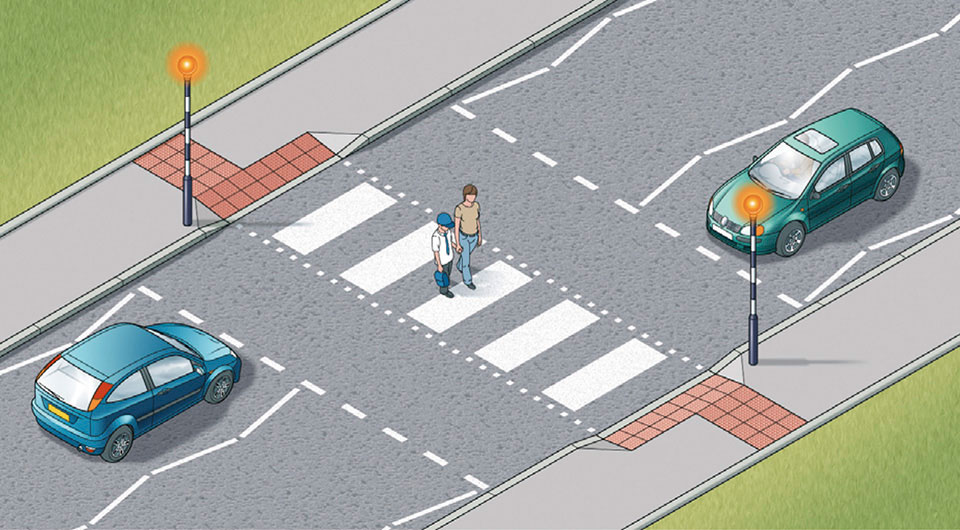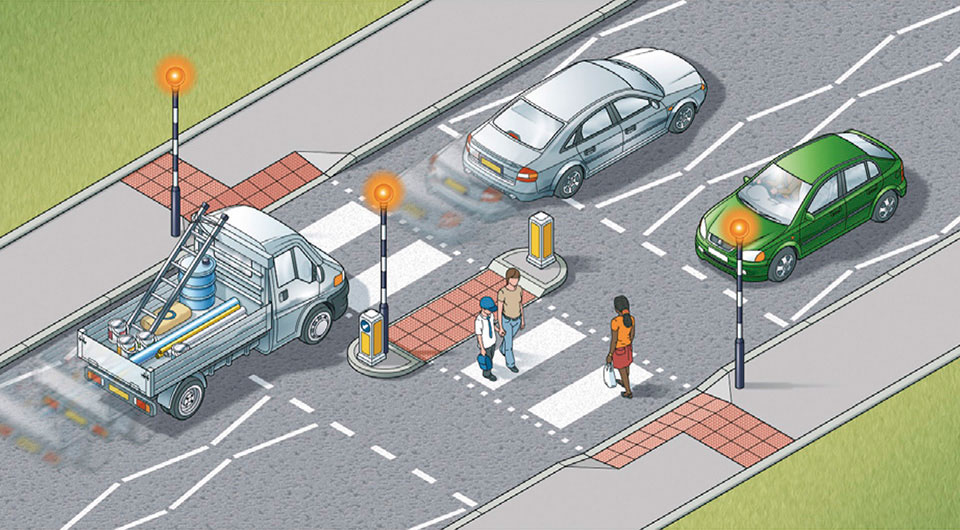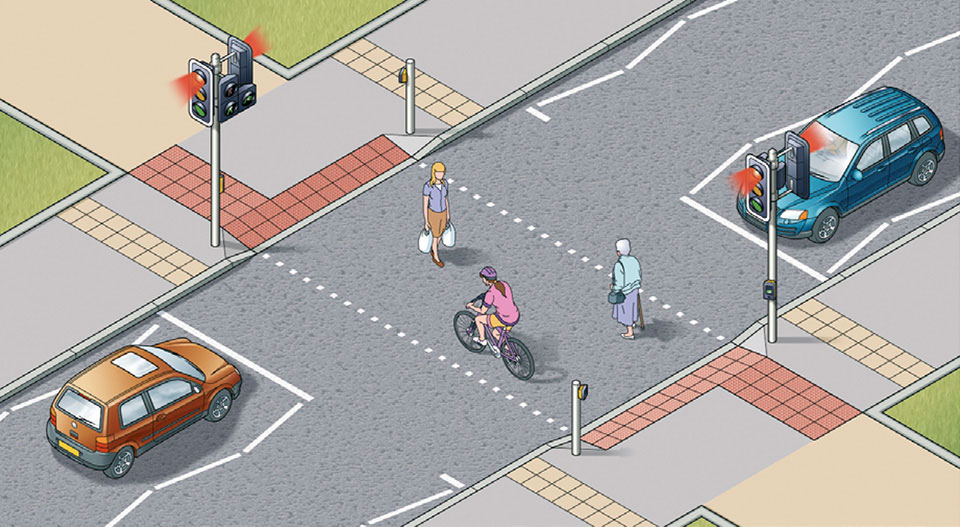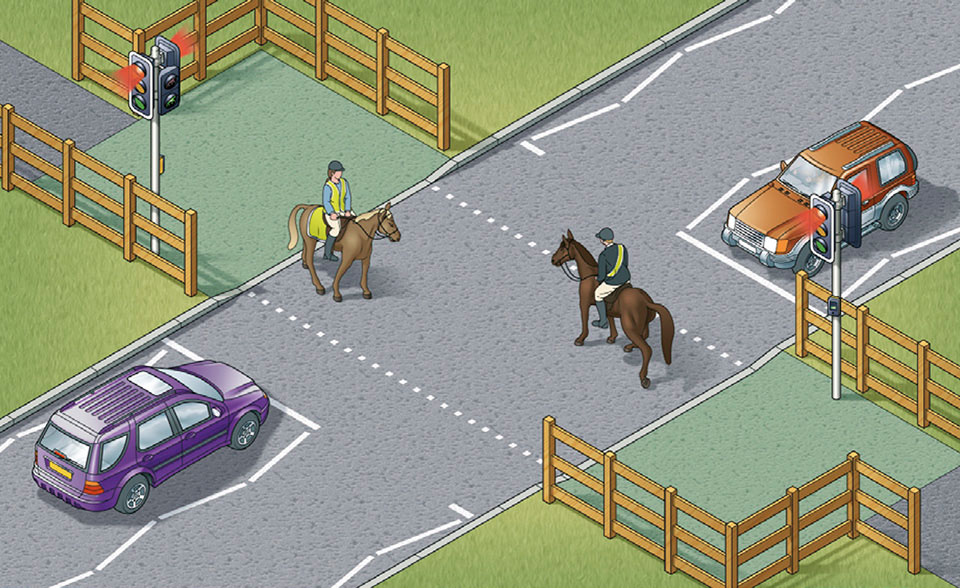There are numerous pedestrian crossings around that assist pedestrians in crossing roads. During your driving test, the examiner will be looking out for how you deal with pedestrian crossings to make sure that you are approaching them in the safest possible way. Learner drivers are often caught out on pedestrian crossings in the driving test and it is a common reason for failing due to the strict regulations of examiners.
In this article we will go through the different types of pedestrian crossings that you might come across, and how to approach these correctly to help you secure the driving test pass.
Types of pedestrian crossings

Pedestrian crossings come in two different types – uncontrolled and controlled. In the next section, we will explain the important distinguishing features of both types and how you should properly approach each different type.
The following two are uncontrolled crossings:
Zebra Crossing
It is likely that you will be familiar with zebra crossings and will have used them as a pedestrian. They are uncontrolled crossings which are marked by black and white stripes on the road, you will also notice two yellow beacons on either side of the road which will be flashing. Leading up to the zebra crossing there will be zigzag lines on both sides of the road to highlight there is a pedestrian crossing ahead – these are a no parking zone.
On your approach to the zebra crossing, you need to check if there is anyone at the crossing, on the crossing or if there is a pedestrian that will soon be about to cross. Depending on what the situation is you need to either slow down or come to a stop. Make sure that you allow the pedestrian to fully cross the road before you set off again.
In some cases, you will find a central island, splitting two smaller zebra crossings, on wider sections of road. If you approach this sort of zebra crossing you do not need to stop if there is a person waiting to cross on the other side of the road to where you are driving.
Contrary to what you may have seen, it is not good practice to wave someone across on a zebra crossing. It is up to the pedestrian themselves to decide if they wish to cross, as there may be waiting to see if the car on the other side of the road is going to stop also. You must never overtake a vehicle at a zebra crossing.
School Warden Crossing
Another uncontrolled crossing is a school warden crossing. This is where a lollypop person in a bright yellow jacket is in place to help children to cross the road, usually near the entrance of a school but also on busier roads nearby.
Make sure you keep a lookout for such warden crossings when you are driving near a school, especially if you are driving near to school start and finish times. Practice the mirror signal manoeuvre routine on approach to the crossing and be ready to stop should the warden signal for you to do so. Always drive with caution near to a school as there will be children who could potentially run into the road or attempt to cross without the warden’s help.
The following four are controlled crossings:
A controlled crossing is a crossing that is controlled by traffic lights. Below are some of the most common controlled crossings that you will come across.
Pelican Crossing
Perhaps one of the most familiar pedestrian crossings is the pelican crossing. This is controlled by a set of traffic lights, and pedestrians can request to cross by pressing a button and waiting for the green man to indicate they can cross. There is also usually a beeping sound to accompany the green man. The red light will be on for drivers as the green man shows for pedestrians.
When the green man starts flashing the amber light will flash for drivers – during this time drivers should not move if there are still pedestrians crossing the road. If there are no more pedestrians crossing when the amber light shows – drivers can move on.
Some pedestrian crossings have a central island in the middle. If the crossing goes straight across the road you need to treat it as one crossing, whereas if it is staggered (with two separate sets of buttons for pedestrians) you can treat it as two crossings.
Puffin Crossing
Puffin crossings are more intelligent than pelican crossings. They have sensors on top of the lights and in the pavement so they know when a person has finished crossing. In this way, the lights will only stay red as long as it takes for the person to cross and will go back to green once that person is across (and there is no one else wanting to cross). This can help to keep traffic moving during busy times, it also has the benefit of giving pedestrians as long as they need to cross without being rushed by a timer.
Toucan Crossings
Designed for cyclists, toucan crossings enable cyclists to cross without having to get off their bike (whereas normally they should dismount). Toucan crossings have a green and red bike alongside the red and green man lights.
Equestrian Crossings
As the name suggests, equestrian crossings are designed for horse riders. They allow a rider to stay on their horse as the button to request to cross is higher than normal.
Key rules for approaching pedestrian crossings
Identifying Pedestrian Crossings
As a careful driver, you will always be in tune with what is coming up on the road ahead of you. In this way, you will be able to identify the indications that a pedestrian crossing is approaching – this could be in the form of a triangular warning sign, flashing yellow beacons or zigzag markings as you approach.
Mirror Signal Manoeuvre
Now you have identified the crossing, you need to go through the mirror signal manoeuvre so that you can drive up to the crossing in a safe way.
- Mirrors – look in all of your mirrors so that you can see what is behind you, and be able to make an accurate assessment of the distance and speed of the traffic that is following you.
- Signal – the only signal you need will be your brake lights which will come on as you slow down, this will indicate to other drivers that are behind you that you are reducing your speed.
- Manoeuvre – ensure that you remain in the normal driving position on the road, you also should not overtake any vehicles when you are approaching a pedestrian crossing. As you approach the crossing, reduce your speed and look out for any pedestrians that are wanting to cross the road. Be aware of any lights that might be about to change. If you are required to stop at the crossing, you must stop before the crossing making sure that you do not stop the car in the pedestrian crossing area. When in a traffic jam, always leave a gap when queuing near a pedestrian crossing so that people are still able to safely cross the road.
Conclusion
Being aware of pedestrian crossings is a key part of safe driving. Make sure that you are always looking ahead and practice the mirror, signal, manoeuvre routine as you approach a crossing and ensure that you allow pedestrians to fully cross the road before moving off.







There are 2 comments
If a local pelican crossing doesn’t beep, to whom do I report it to to get it fixed?